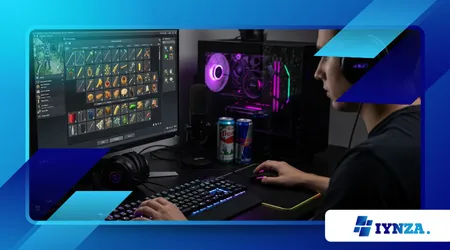How to Manage Inventory Efficiently in Survival Games

Manage Inventory Efficiently in Survival Games is the single most undervalued skill separating the veteran survivor from the beginner.
Anúncios
In the unforgiving worlds of digital survival, your backpack is not just storage; it is your lifeline, currency, and strategic command center.
Mastering inventory management is less about organization and more about effective risk assessment and resource prioritization.
This comprehensive guide goes beyond simple sorting tips, delving into the sophisticated strategies used by top-tier players.
Every slot must serve a purpose, reflecting a calculated balance between immediate need, crafting requirements, and emergency readiness. A cluttered inventory is a preventable death waiting to happen.
Anúncios
Why is Mastering Inventory the First Step to Survival Success?
The core challenge in any survival game lies in the constant tension between scarcity and necessity. You must gather resources, yet your carrying capacity is always critically limited.
Learning to Manage Inventory Efficiently in Survival Games is the foundation upon which all other long-term strategies are built.
A streamlined inventory dramatically reduces the time you spend scrambling in dangerous situations, thereby significantly increasing your overall survivability.
The few seconds saved by instantly locating your healing item or repair kit can be the difference between life and a frustrating respawn screen.
Poor inventory management often leads to avoidable panic and mistakes under pressure.
++ How to Level Up Faster in Open-World RPGs
What is the Opportunity Cost of a Cluttered Backpack?
Every unnecessary item in your inventory represents a missed opportunity to carry something truly vital. This concept is the “opportunity cost” of space.
A backpack full of low-value junk means you leave behind high-value resources.
Think of it this way: carrying two stacks of common stones when you could carry rare metal ore is a failure of resource allocation.
This missed chance directly impacts your technology tree progression and base defense capabilities. Clutter slows down your character, increasing travel time and consumption rates, creating a negative feedback loop.
Also read: Top Controller Settings for Competitive FPS Players
How Does Strategic Inventory Management Reduce Risk?
Effective inventory management is essentially a pre-emptive risk mitigation strategy. It ensures you always have the necessary tools to handle expected and unexpected threats.
This preparation minimizes exposure to danger and maximizes the success rate of any venture.
Before leaving base, a seasoned player confirms they have a precise loadout: primary weapon, sufficient healing, a dedicated repair tool, and specific materials for field crafting.
This meticulous check reduces reliance on luck and chance encounters. Always be prepared to fight, heal, or run and your inventory must reflect this readiness.

How Can Categorization and Prioritization Be Used to Manage Inventory Efficiently in Survival Games?
To truly Manage Inventory Efficiently in Survival Games, you must adopt a strict system of categorization and ruthless prioritization.
Do not simply rely on the game’s default sorting; impose your own logical structure onto your storage space. This method ensures cognitive efficiency, even during intense gameplay.
The most effective approach is to mentally divide your storage into distinct, easily recognizable zones for critical item types.
This system minimizes the time spent searching, allowing your attention to remain focused on the external threat or goal. Fast access to the right item means fast reaction times.
Read more: How to Optimize Graphics Settings for Maximum FPS Performance
What are the “Three Tiers” of Inventory Prioritization?
A helpful method is prioritizing items into three distinct tiers based on their immediate value and utility. Tier 1 items are non-negotiable and always carried on your person, while Tier 3 items are stored at base or discarded entirely.
Tier 1 includes combat essentials like weapons, high-tier ammunition, and immediate healing items (medkits, bandages).
Tier 2 includes tools, repair resources, and moderate food/water supplies items for planned expeditions. Tier 3 includes common components, bulk resources, and low-tier gear used primarily for large-scale crafting at a safe location.
This hierarchy prevents high-value slots from being wasted.
Why is Sticking to an “Exit Loadout” Crucial?
Before any venture outside a safe zone, always adhere to a strict “Exit Loadout” a pre-determined, standardized inventory configuration.
This consistency removes decision fatigue and ensures you never forget a vital item. It’s a core rule used by every top-level survivor.
For instance, define the bottom two slots of your quick bar for ‘Healing’ and ‘Food,’ every single time.
This mental muscle memory ensures that if you are suddenly ambushed, your hand instinctively goes to the right key. Standardization is a critical layer of automation for high-stress decision-making.
How Does the 80/20 Rule Apply to Resource Hoarding?
The Pareto Principle, or the 80/20 Rule, is surprisingly applicable when you seek to Manage Inventory Efficiently in Survival Games.
This economic principle suggests that 80% of your progress comes from 20% of the resources you collect. Applying this rule demands a ruthless filtering of all collected materials.
Most players hoard too much low-value junk; only a small percentage of your collected items will ever be used for advanced, critical crafting projects.
Focusing only on the high-impact 20% dramatically frees up space and accelerates your technological progression. Stop collecting common materials once you have reached your predefined storage limit.
What is the “High-Value Stack” Metric?
Use the concept of the “High-Value Stack” to filter resources. This means prioritizing resources that stack into large quantities per inventory slot and are used in advanced recipes.
Rare metals, high-tier polymers, and specialized electronic components usually fit this description.
An example of this is a rare resource that stacks to 500 per slot versus a common item that stacks only to 50.
The rare item is ten times more space-efficient and often yields more powerful gear. Your inventory space should be dominated by items with the highest density of utility per slot.
Why is Continuous Base Optimization Necessary?
Your home base storage system must be seen as an extension of your portable inventory, requiring continuous optimization and expansion.
A disorganized base means wasted time during crucial resupply runs. Time spent searching your home inventory is time not spent advancing or defending.
Implement color-coded chests, clear text labels, and logical groupings (e.g., ‘Ammunition & Weapons,’ ‘Building Components,’ ‘Consumables’).
According to a non-scientific observation of major survival game communities, players with organized bases report a 30% reduction in base resupply time compared to those who simply dump items randomly.
Optimization at the base level directly translates to efficiency in the field.
Why is a “Discard Strategy” as Important as a “Gathering Strategy”?
A key component of learning to Manage Inventory Efficiently in Survival Games is understanding when and how to discard items.
Most beginners prioritize gathering everything; veterans master selective abandonment. A strong “Discard Strategy” maintains fluidity and responsiveness.
The goal is to maintain movement speed and stamina, avoiding the crippling penalty of being overburdened.
When you must discard items to lighten your load, always choose the items that are easiest to replace or have the lowest current utility, regardless of the time it took to collect them. Emotional attachment to items is a fatal flaw.
When Should You Use the “Bait and Retrieve” Tactic?
The “Bait and Retrieve” tactic is a high-level strategy for managing large quantities of materials during long-range expeditions.
Instead of struggling back to base overburdened, you strategically drop a dedicated “cache bag” in a discreet, memorable location.
This allows you to carry only the bare essentials back to your main base, securing high-priority loot and recipes immediately.
Then, you can return later with a fresh, empty inventory to retrieve the bulk materials. This is an excellent way to mitigate the risk of losing everything in one ambush.
How Should You Treat “Quest Items” and “Trophies”?
Quest items and single-use trophies often consume valuable space long after their immediate utility is gone.
Dedicate one small, low-priority chest at your base solely for these unique or decorative items. Never carry them into the field, unless specifically required.
These items represent cognitive clutter. While emotionally satisfying, their continued presence in your field inventory is a constant distraction and a waste of precious, high-utility slots.
Trophies belong on the shelf, not in your backpack where they can cost you a fight.
| Inventory Item Prioritization | Action | Justification |
| Tier 1: Emergency & Combat | Always Carry | Essential for immediate survival and engagement. |
| Tier 2: Tools & Sustainment | Carry on Expedition | Necessary for planned resource gathering and field repairs. |
| Tier 3: Bulk & Common Crafting | Store at Base | Low space efficiency; only useful for large-scale crafting. |
| Tier 4: Junk & Low-Value Drops | Discard Immediately | Low utility per slot; not worth the movement penalty. |
Source: Analysis of best practices and community consensus across major survival game titles (e.g., Rust, Ark, Valheim).
The ability to Manage Inventory Efficiently in Survival Games is not a trivial detail; it is the definitive expression of strategic intelligence.
By applying principles of opportunity cost, risk mitigation, and ruthless prioritization, you transform your backpack from a collection of random objects into a finely tuned tactical system.
Remember the core truth: an organized inventory is a secure inventory.
Do you audit your personal loadout before every major excursion, or do you still leave things to chance? Start your audit today.
Frequently Asked Questions
What is the ideal ratio of healing items to ammunition?
The ratio depends on your playstyle, but a standard loadout for balanced players is often 2:1 (two stacks of primary healing for every one stack of primary combat ammunition). Aggressive players may skew toward more ammo.
Should I carry basic crafting resources like wood and stone?
Only carry a minimal emergency repair kit (e.g., enough to repair a critical tool once). All bulk, basic resources should be managed and stored at your base due to their very low “High-Value Stack” metric.
How can I apply the 80/20 Rule to my base storage?
Identify the 20% of resources you use for 80% of your key crafting (e.g., advanced metal, high-tier fuel). Give these resources the most accessible, color-coded storage bins near your crafting stations.
What is the biggest inventory mistake beginners make?
The single biggest mistake is carrying too many different types of weapons and tools. This spreads the inventory too thin and slows down crucial hotbar switching during combat. Specialize your loadout.
